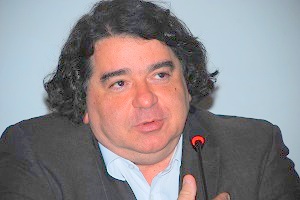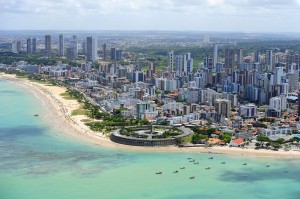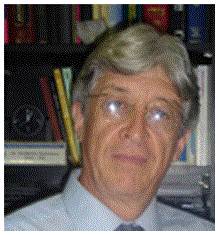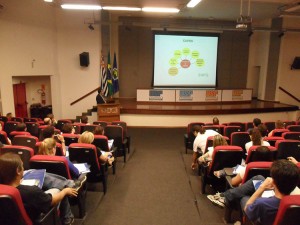
On May 6th, at the Naval School of Rio de Janeiro, the Brazilian Academy of Sciences (ABC) held the tenure ceremony of its new members, elected in a process of nomination and evaluation by their peers, performed throughout 2013. In the event, 24 scientists were assigned as full members of ABC. Among those, in the field of Physical Sciences, there was Professor Fernando Lázaro de Freire Junior, Materials researcher and former president of SBPMat.
Contemplating the ideia of being a researcher, Fernando Lázaro chose to graduate with a Bachelor’s degree in Physics by the Pontifical Catholic University of Rio de Janeiro (PUC-RIO), earning it in 1978. In 1979, he started teaching in the same university, while attending his Master’s (1979-1981) and Doctorate (1981-1985) courses in Physics there. During his graduate studies, Fernando Lázaro made his first scientific interventions in the field of Materials by means of an ion accelerator, initially used by him for works in Atomic Physics. In 1998, he went to Università degli Studi di Padova (in Italy) for his Postdoctoral studies, working with materials surfaces and interfaces.
From 2003 to 2008, he was the Director of PUC-Rio’s Physics Department. From 2008 to 2012, he coordinated the field of Physics and Astronomy in the Research Foundation of the State of Rio de Janeiro (FAPERJ). In Europhysics Letters (a journal from the European Physical Society), Professor Lázaro worked as coeditor between 2006 and 2010, and advisory editor from 2010 to 2013. In SBPMat, he served two consecutive terms as president, two as scientific director and one as financial director.
Currently, Fernando Lázaro is a Full Professor in PUC-Rio and director of Centro the Brazilian Center for Research in Physics (CBPF), in addition to being a member of the FAPERJ’s Higher Board and coordinator of the National Institute of Surface Engineering. Author of over 170 scientific articles, with more than 2500 citations, he is a level 1A researcher in the Brazilian National Research Foundation, CNPq. Among his most relevant papers, there are several studies on carbon-based materials: DLC (diamond-like carbon) films, nanotubes and, more recently, graphene.
Following there is a brief interview with the researcher.
SBPMat newsletter: – Tell us a little about your history: what led you to become a scientist and work in the field of Materials?
Fernando Lázaro: – I always enjoyed Physics and Mathematics during high school, but in 1974 I had no ideia, when I applied for college entrance exams, that it was possible to do research in Brazil. Because of this, I took the exam to major in Electrical Engineering in PUC-Rio, and only there I realized that it was possible to perform researches in the field of Physics, in Brazil. Then, I transferred myself to the Bachelor’s in Physics, which was easier, as in 1975 PUC-Rio already had a common Basic Cycle for the whole of its Scientific and Technical Center. So, I didn’t waste any time. I was in my second year in the undergraduate studies. My graduate studies, then, still in PUC-Rio, were in Atomic Physics, using an ion accelerator as a working tool. As such accelerator was also a great tool to analyze materials, it was through this path that I entered into the field of Materials.
SBPMat newsletter- What do you consider as your main contributions to the field of Materials?
Fernando Lázaro: – My research has always been conducted in collaboration with several colleagues and students, and I think we made an important contribution to the study of nanostructured carbon films (diamond-like carbon films, DLC), as attested by the papers with a high number of citations and all the invitations to be invited lecturer in many international congresses. It is evident that supervising students has been important too, as well the management positions in PUC-Rio, CBPF and SBPMat.
SBPMat newsletter: – Choose some of your more highlighted papers, and comment on them, if possible.
Fernando Lázaro: – My most cited paper is an article in Applied Physics Letters, published in 1992, coauthored by Carlos Achete, from COPPE/UFRJ, and Dante Franceschini, currently at UFF, on the nitrogen incorporation in DLC films [Franceschini, D. F. ; Achete, C. A. ; Freire Junior, F. L. Internal Stress Reduction By Nitrogen Incorporation In Hard a-C:H Thin Films. Applied Physics Letters, New York, v. 60, p. 3229-3231, 1992]. It was released at the right time, and offered a relevant result for the issue of the applications of such materials, namely, the decrease of the internal tension of the film (an important factor in the debonding of films from the substrates), without a significant change in its hardness.
SBPMat newsletter: – In your opinion, what are the main challenges in your current research field for Materials Science and Engineering?
Fernando Lázaro: – I have been working with graphene and carbon nanotubes. For both, the production of good quality samples, in a controlled and profitable form, still represents a great obstacle for the use of those materials in a broader way than the one that has been verified up to this point.
SBPMat newsletter: – Send a message to our readers who are starting their careers as scientists.
Fernando Lázaro – An encouraging message. The material working conditions nowadays are much better than when I started, three decades ago; the same can be said about the wages in academia. So, things have improved and tend to keep getting better, and I think it is feasible to conduct good quality researches, with an international impact, in Brazil.







